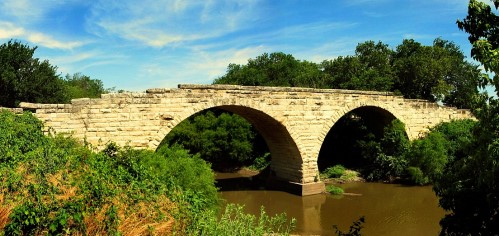First published in The Emporia Gazette December 2, 2003
A THIN PLACE
by Cheryl Unruh
Standing on the stone arch bridge at Clements, I hear only silence.
Gradually, the background noise shifts into the present moment.
A few birds chatter. A dog barks off in the distance. Water gurgles as it slips downstream in the Cottonwood River.
Earlier on that warm Sunday in November, my husband and I enjoyed breakfast alongside the bikers at the Emma Chase Café in Cottonwood Falls.
The biker breakfast was quite a meal: a biscuit with gravy, bacon, link sausage, scrambled eggs, hash browns, and another biscuit for the homemade apple butter.
Full and happy, Dave and I then drove west on U.S. Highway 50, past Elmdale and the Clover Cliff Ranch.
We turned at Clements, a tiny town past its prime, to visit the stone arch bridge, which is on the National Register of Historic Places.

Built in 1886 by the L.P. Santy Co., the bridge has two high and graceful arches and is made of large rectangular chunks of native limestone.
I leaned my forearms on the stone bridge and glanced up at a swath of cirrus clouds in the thin blue sky. The sun was warm, the air still. It felt like home.
Trips into the Flint Hills always restore me to a sense of wholeness. I feel those lost parts of myself return.
I imagine that most people know of a place where they feel renewed and complete. One person might feel most at home while hiking a mountain trail, another at a farm pond with a fishing line in the water.
Sometimes I drive through the open range east of Matfield Green. My car rattles over the cattle guards; it fords small rock-bottomed streams.
In many places on the open range, other than your vehicle and the road it is on, there is nothing man-made in sight: no fences, no houses, no power poles. You’ll see only grassy hills dotted with white rocks, scattered as if flung from above.
These gravel roads wind like rivers, pulling me up and around the hills. At the edge of the roadway, grass flows ever outward, spreading like a chain reaction.
Chlorophyll has slithered back into the ground. The November fields reflect various shades of umber, sienna, ochre. Tops of little bluestem catch the sun and look like magical wands, white and luminescent.
I am drawn to the open landscape, the uncluttered space. A sense of freedom comes with this unobstructed view.
These hills haven’t changed much in 10,000 years. Before this region became a rocky pasture, it was an inland sea--about 250 million years ago during the Permian Period of the Paleozoic Era.
Here on the lonely prairie, I begin to understand the irrelevance of time, the reach of infinity.
This is a sacred landscape.
On a Sunday morning last winter I drove south on the Kansas Turnpike to visit a friend in Wichita.
I left Emporia before sunrise that morning. Few cars were out on the highway. I had the road, the sky and the scenery all to myself.
Just outside of Emporia, the turnpike tumbles into the Flint Hills. The earth flows like huge ocean waves, brown undulations, rising and falling.
While I drove, light pulled itself into the eastern sky.
Form is everything. Sky is everything. Light is everything.
That morning, as the sun tipped above the horizon, it charged the highest rises of earth with vigorous beams. The land had only two colors: shadow and light.
In “Living Between Worlds,” Philip Sheldrake mentions “ . . . ‘a thin place’ where the membrane between this world and the other world, between the material and the spiritual, was very permeable.”
There are moments, if one is lucky enough, to be in both worlds at once.
Copyright 2004 by Cheryl Unruh
back to topAll Content Copyright 2004 by Cheryl Unruh
Text by Cheryl Unruh | Web Design: Dave Leiker
Photography by Cheryl Unruh & Dave Leiker